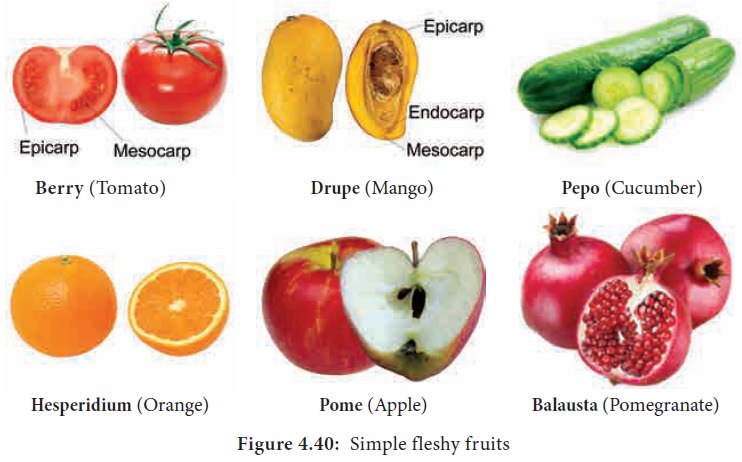Botany - Simple Fruits and its Types: Fleshy and Dry Fruit | 11th Botany : Chapter 4 : Reproductive Morphology of Angiosperm
Chapter: 11th Botany : Chapter 4 : Reproductive Morphology of Angiosperm
Simple Fruits and its Types: Fleshy and Dry Fruit

Fruits are classified into various types:

Simple Fruits
The fruits are derived from a single ovary of a
flower Example: Mango, Tomato. Simple fruits are classified based on the nature
of pericarp as follows
A. Fleshy Fruit
The fruits are derived from single pistil where the pericarp is fleshy, succulent and differentiated into epicarp, mesocarp and endocarp. It is subdivided into the following.
![]()
![]()
![]()
a) Berry: Fruit develops from bicarpellary or multicarpellary, syncarpous ovary.
Here the epicarp is thin, the mesocarp and endocarp remain undifferentiated.
They form a pulp in which the seeds are embedded. Example: Tomato, Date Palm,
Grapes, Brinjal.
b) Drupe: Fruit
develops from monocarpellary, superior ovary. It is usually one seeded.
Pericarp is differentiated into outer skinny epicarp, fleshy and pulpy mesocarp
and hard and stony endocarp around the seed. Example: Mango, Coconut.
c) Pepo:
Fruit develops from tricarpellary inferior ovary. Pericarp terns leathery or
woody which encloses, fleshy mesocarp and smooth endocarp. Example: Cucumber,
Watermelon, Bottle gourd, Pumpkin.

d) Hesperidium: Fruit develops from multicarpellary, multilocular, syncarpous, superior ovary.
The fruit wall is differentiated
into leathery epicarp with oil glands, a middle fibrous mesocarp. The endocarp
forms distinct chambers, containing juicy hairs. Example: Orange, Lemon.
e) Pome: It
develops from multicarpellary, syncarpous, inferior ovary. The receptacle also
develops along with the ovary and becomes fleshy, enclosing the true fruit. In
pome the epicarp is thin skin like and endocarp is cartilagenous. Example:
Apple, Pear.
f)
Balausta: A fleshy indehiscent fruit
developing from multicarpellary, multilocular inferior ovary whose pericarp is
tough and leathery. Seeds are attached irregularly with testa being the edible
portion. Example: Pomegranate.
B. Dry Fruit
They develops from single ovary where the pericarp is dry and not differentiated into epicarp, mesocarp and endocarp. It is further subdivided into three types.
1) Dry dehiscent fruit
Pericarp is dry and splits open along the sutures
to liberate seeds. They can be classified into following types.
a)
Follicle: Fruit
develops from monocarpellary,
superior ovary and dehisces along one suture. Example: Calotropis.
b)
Legumeorpod:Fruit develops from monocarpellary, superior
ovary and dehisces through both dorsal and ventral sutures. Example: Pisum.
c) Siliqua: Fruit develops from bicarpellary, syncarpous, superior ovary initially one chambered but subsequently becomes two chambered due to the formation of false septum (replum). The fruit dehisces along two suture. Example: Brassica.

d)
Silicula: Fruit
similar to siliqua but shorter and
broader. Example: Capsella, Lepidium, Alyssum.
e)
Capsule: Fruit
develops from multicarpellary,
syncarpous, superior ovary. Based on the dehiscence pattern they are sub
divided into.
i)
Septicidal:
Capsule
splitting along septa and valves
remaining attached to septa. Example: Linum,
Aristolochia.
ii)
Loculicidal:
Capsule
splitting along locules and values
remaining attached to septa. Example: Lady’s finger.
iii)
Septifragal: Capsule splitting so that valves fall off leaving seeds attached to the central
axis. Example: Datura.
iv)
Poricidal:
Dehiscence
through terminal pores. Example: Papaver.
v)
Denticidal:
Capsule
opening at top exposing a number of
teeth. Example: Primula, Cerastium.
vi)
Circumscissile:
(pyxidium) Dehisces transversely so that top comes off as a
lid or operculum. Example: Anagallis arvensis, Portulaca, Operculina.
![]()
![]()
![]()
2) Dry indehiscent fruit
Dry fruit which does not split open at maturity. It
is subdivided into.
a) Achene: Single seeded dry fruit developing from single carpel with superior ovary. Achenes commonly develop from apocarpous pistil, Fruit wall is free from seed coat. Example: Clematis, Delphinium, Strawberry.
b)
Cypsela: Single
seeded dry fruit, develops from
bicarpellary, syncarpous, inferior ovary with reduced scales, hairy or feathery
calyx lobes. Example: Tridax, Helianthus.

c)
Caryopsis: It is a
one seeded fruit which develops from
a monocarpellary, superior ovary. Pericarp is inseparably fused with seed.
Example: Oryza, Triticum.
d)
Nut: They
develop from mulicarpellary,
syncarpous, superior ovary with hard, woody or bony pericap. It is a one seeded
fruit. Example: Quercus, Anacardium.
e)
Samara: A dry
indehiscent, one seeded fruit in
which the pericarp devlops into thin winged structure around the fruit.
Example: Acer, Pterocarpus.
f)
Utricle: They
develops from bicarpellary,
unilocular, syncarpus, superior ovary with pericarp loosely enclosing the
seeds. Example: Chenopodium.
3) Schizocarpic Fruit
This fruit type is intermediate between dehiscent
and indehiscent fruit. The fruit instead of dehiscing rather splits into number
of segments, each containing one or more seeds. They are of following types.
a)
Cremocarp: Fruit develops from bicarpellary,
syncarpous, inferior ovary and splitting into two one seeded segments known as mericarps. Example: Coriander, Carrot.

b) Carcerulus: Fruit develops from bicarpellary, syncarpous, superior ovary and splitting into four one seeded segments known as nutlets. Example: Leucas, Ocimum, Abutilon
c)
Lomentum:
The fruit
is derived from monocarpellary,
unilocular ovary. A leguminous fruit, constricted between the seeds to form a
number of one seeded compartments that separate at maturity. Example: Desmodium, Mimosa
d)
Regma: They
develop from tricarpellary,
syncarpous, superior, trilocular ovary and splits into one-seeded cocci which
remain attached to carpophore. Example: Ricinus,
Geranium
Related Topics